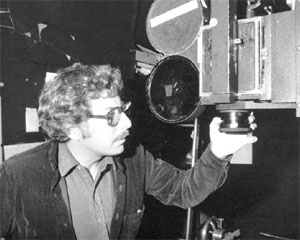
Robert Forget
2012 Canadian Digital Media Pioneer Award Recipient

Photo courtesy of the National Film Board of Canada
Robert Forget has been a true digital media pioneer in Canada. As a producer in the French Animation Studio at the National Film Board, he championed a number of experiments to find out how appropriate adoption of technology could enhance and extend Canadian cultural expression. His many contributions are part on a larger tradition of exploring new technologies at the NFB that has earned it an international reputation for artistic and cultural excellence and innovation.
Robert’s interest in the interplay between communication arts and technology led him to examine ways to effectively use technology in both the creation and distribution phases of the artistic and cultural process and to seek to fully engage the NFB with a broader cross-section of society.
In 1971, he helped create Le Videographe, the first centre in Canada for artists working in video production. In 1992, he was instrumental in launching CinéRobothèque in Montréal’s Latin Quarter.
His willingness to embrace new technology and discover how it could be put into practice, his recognition that this had to be done in the context of actual work, and his understanding of the importance of building early prototypes to test out ideas underlies much of what Robert Forget is celebrated for.
Robert subsequently guided the growth of computer animation at the NFB through a series of enhancements to the computer animation software that had been developed under an earlier collaboration with the National Research Council. The importance of these initiatives for the NFB was recognized when the Centre d’animatique was authorized in December 1984.
In 1993 Robert took on the role of Director for Technical Services at the NFB. He continued to look for ways to use digital technology in the filmmaking process. Under his leadership non-linear on-line editing, which was still in its infancy, was first used at the NFB.
Robert had a knack for seeing the potential in new technologies before others did.
In all of these efforts, Robert Forget never lost sight of the fact that technology is not the end goal, but merely a means for producing or distributing an artistic or cultural work. Each of the innovations he introduced over his career provided new tools for filmmakers to explore and new ways for the public to gain access to the filmmakers’ work. In this he remained true to his predecessor’s vision for the role of technology:
And so it was important that the animation studio, rather than imposing or favouring a technique, encourage filmmakers to discover and develop the technique best suited to the specific needs of a given film. In short, the right to question provides the freedom necessary for experimentation and innovation. – René Jodoin
It is with great pride that Robert Forget is being recognized as a Canadian Digital Media Pioneer for his many accomplishments and contributions to advancing the state of the art and for providing an environment at the NFB where others were able to gain early access to emerging technologies in a way that supported their individual explorations of digital media. His vision and dedication have helped maintain the National Film Board’s international presence as an innovative cultural institution.
Biography
Born in 1938, Robert Forget pursued a BSc in biology and an MSc in physiology. He made a Super 8 film using pixillation techniques in 1961, and through this effort he first met Norman McLaren, founder of Studio A, the original animation unit at the NFB. Four years later, Robert joined the National Film Board as a director of educational films in biology and science. He gained experience working with René Jodoin, then head of the French Animation Studio. He succeeded Jodoin in 1978 and later became head of French Production, before taking on the role of Director for Technical Services at the NFB in 1993. Robert’s interest in the interplay between communication arts and technology led him to seek to fully engage the NFB with a broader cross-section of society. In 1971, he helped create Le Videographe, the first centre in Canada for artists working in video production. Robert was instrumental in the 1992 launch of CinéRobothèque in Montréal’s Latin Quarter, providing free access to more than 10,000 films from the NFB collection.
Robert produced 33 films at the NFB and over 85 films in his entire career, including Anniversary, Better Housing for British Columbia, Bioscope, If Only..., Little Burgundy, Memories of War, Mirrors of Time, Still Point, Tocade, Two Sisters, Une âme à voile, With Drums and Trumpets, Wow, and Zea.
Selected Works
- Two Sisters / Entre deux soeurs (1991)
- Mirrors of Time / Les miroirs du temps (1991)
- Anniversary / L’Anniversaire (1989)
- Felicity / Félicité (1989)
- La Lettre d’amour (1989)
- Of Lives Uprooted (1988)
- If Only ... / Si seulement... (1987)
- Itinerary / Itinéraire (1987)
- Tocade (1987)
- Nightangel / L’Heure des anges (1986)
- A Matter of Form / Question de forme (1984)
- Bioscope (1984)
- Mushrooms / Champignons (1984)
- Opéra zéro (1984)
- Rectangle & Rectangles / Rectangle et Rectangles (1984)
- Songs and Dances of the Inanimate World: The Subway / Chants et Danses du monde inanimé - Le Métro (1984)
- Still Point (1984)
- Listen, You’ll See... / Écoutez voir (1983)
- Memories of War / Souvenirs de guerre (1983)
- Une âme à voile (1982)
- “E” (1981)
- One Way Street / Les Naufragés du quartier (1980)
- The French World Comes to Québec (1975)
- Little Burgundy / La P’tite Bourgogne (1969)
- Multiple Man / L’Homme multiplié (1969)
- The Battle of St-Denis... Yesterday, Today (1969)
- Sheer Sport (1969)
- Capital on the Ottawa (1968)
- Better Housing for British Columbia / La Colombie-Britannique et l’habitation (1967)
- Indian Memento / Mémoire indienne (1967)
